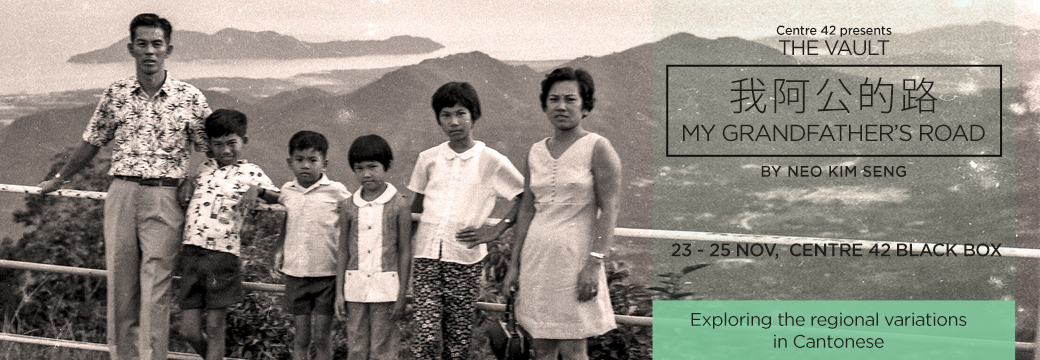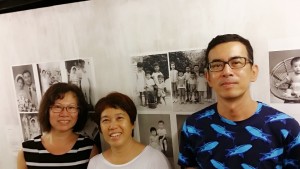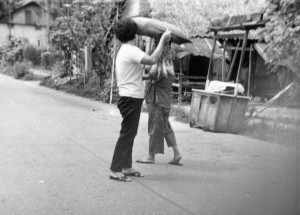
In 2015, independent theatre producer Neo Kim Seng presented a work titled My Grandfather’s Road as part of Cake Theatrical Productions’ 10th anniversary celebrations, Running with Strippers. It comprised a photo exhibition, a book launch, and an English-language monologue, which together form a montage of his childhood memories growing up on Neo Pee Teck Lane – a road in Pasir Panjang that’s named after his paternal grandfather.
Two years on, Kim Seng has decided to revisit the monologue as part of Centre 42’s Vault programme. This time, he is working with two actors to present the piece in Cantonese, the spoken language of his childhood. Two versions will be showcased – one in Singaporean Cantonese, and one in Malaysian Cantonese – so that he can explore the regional variations in the language.
We chat with Kim Seng to find out more about My Grandfather’s Road.
How did the original My Grandfather’s Road in 2015 come about?
Cake Theatrical Productions invited me to be part of their Decimal Points project, spread over two years. I presented Decimal Points 810 in 2014 which was inspired by my open-heart surgery in 2013. The second presentation eventually became part of Cake’s 10th anniversary celebrations, Running With Strippers. I originally wanted to continue with the second part of a planned trilogy, but Cake suggested that I think of a project that can have a life after its first incarnation. So I decided on a three-part project, a photo-installation, a book and a monologue about growing up on a road named after my paternal grandfather Neo Pee Teck Lane. It was not a nostalgic research project but looked at reconnecting with things and people from my past and present.
Why did you decide to revisit it now, and why in Cantonese?
My mother sat through two of my theatre projects and her grasp of English is not that strong. My original intention was just to make a project that she could fully understand. She was very animated and excited when she saw her photos on display at the photo-installation in 2015.
I have received encouraging response to the book. Some suggested that the book could be translated into Mandarin to reach out to more people. Then I thought, why not do a Cantonese version?
I grew up speaking Cantonese. I recently found out that my paternal grandmother was a renegade ma cheh (domestic helper) and I am more Cantonese than I thought. I am less fluent and speak less Cantonese now than when I was younger but somehow a language that you learn orally never goes away and becomes embedded in you. There is a strong emotional attachment to the sound of Cantonese although I may not fully understand the words. The project is about reconnecting to a relegated language, sound and people.
I also like to surprise people and challenge myself because not many people know that I can speak Cantonese.

Neo Kim Seng (right) poses with relatives at the 2015 presentation of “Running with Strippers”.
The Vault monologue presentation will have two versions – one in Singaporean Cantonese, and one in Malaysian Cantonese. Why are you interested in exploring the regional differences of the language?
This is mainly to explore how languages evolve and adapt over time and space/location. The Cantonese that we speak here adopts other Chinese and non-Chinese words over time. Even Hong Kong Cantonese words have crept into Singaporean Cantonese. I thought it would be interesting to find out how pronunciation differed and also different words were used.
Let’s talk about the process of creating The Vault: My Grandfather’s Road. Firstly, how did your actors, Gary Tang and Tan Cher Kian, get involved?
In the many years working in the performing arts field, what I enjoy most is working with new people, because I get a lot of new ideas and energy interacting with them. I had an open audition in June this year. Some friends recommended more experienced actors to me. I was also on the lookout for non-Chinese female performers who could speak Cantonese, because they would approach the stories differently. The first version of My Grandfather’s Road in English in 2015 was performed by a young male actor and I deliberately created a version where on-stage I was this vulnerable person telling bittersweet stories.
Gary was introduced to me by our mutual friend. Gary is very passionate about Cantonese and was on the lookout for opportunities to work on Cantonese projects, something not so common here. He was also very keen to explore the authentic sound of Cantonese and how it evolved over time.
Cher Kian (CK) responded to the audition call and at first only wanted to help with the presentation. He has not acted before but he’s an avid arts lover and attends lots of performances. So we spoke and I found out he is keen to be on the other side of the stage as well. I was very taken by his enthusiasm and interest. The bonus was that he grew up in Sabah and spoke Cantonese fluently.

“This photo is the only photo I have of Neo Pee Teck Lane. The cart on the right is Thaatha’s mee goreng cart!” says Kim Seng
How did you and Gary work to come up with the Singaporean Cantonese version? Was the process very different when you worked with Cher Kian on the Malaysian Cantonese version?
My original plan was to have the English script translated into Mandarin and from there translate the Mandarin into Singaporean and Malaysian Cantonese, for the presentation. The content for both versions will be the same. So I had the script translated into Mandarin by Low Kok Wai.
Gary is born Cantonese and a fluent speaker. Gary decided to rework the original English text into a storyteller version. So he’s a storyteller telling the stories of people who lived on Neo Pee Teck Lane. He wrote the Cantonese text based only on the original English text. Gary’s version is a remixed, reconstructed and reimagined version of the English stories.
CK’s version will be adapted from Kok Wai’s Mandarin translation and the original English text. CK will be performing as me/the narrator telling the stories and is more similar in style to the English monologue and written text.
So the two versions are different variations of the same stories. Since the book was published, I found out some new information and some of this was updated in the Singaporean Cantonese version. I did not want to update the Malaysian Cantonese version. The original English text had a lot of details and fragments of stories and it was impossible to condense all of them. So I went through the original script separately with each actor and we picked the smaller stories that resonated for each of their versions. Their personal response to the original stories was also crucial in shaping their reinterpretations.
I told Gary and CK that, for their presentations, they must speak Cantonese in a way that they are familiar and comfortable with. Their personal language is important in capturing the essence and sound.
And finally, tell us about one of your fondest memories growing up on Neo Pee Teck Lane.
My father once built this imposing fortress-like rectangular structure below our huge rambutan tree from old timber planks, for us to play. I can’t remember where he got those timber from. It was in the shape of a lorry. It was huge, maybe longer than a 14-foot lorry. The neighbourhood children had such great fun playing in it. But I think after a heavy thunderstorm, it became unsafe and father took it down. When I grew up later and see those wooden fortresses and buildings in Akira Kurosawa’s samurai films, I always remember our own wooden fortress under the rambutan tree.
By Gwen Pew
Published on 14 October 2017
Find out more about The Vault: My Grandfather’s Road here, and join us at Centre 42 on 23 – 25 November 2017 by registering for a seat here.





